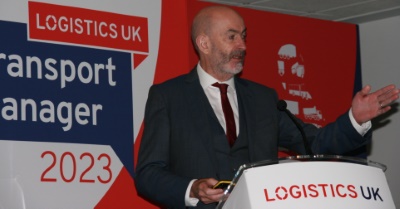TC queries Transport Manager CPC syllabus
 West of England traffic commissioner (TC) Kevin Rooney has questioned the relevance of the current Certificate of Professional Competence syllabus to the core of the transport manager’s role: ensuring safety and legal compliance in a company’s transport operations.
West of England traffic commissioner (TC) Kevin Rooney has questioned the relevance of the current Certificate of Professional Competence syllabus to the core of the transport manager’s role: ensuring safety and legal compliance in a company’s transport operations.
Addressing the Logistics UK Transport Manager conference in Somerset, he said: “Most of the syllabus for the CPC exam is not relevant to most of the transport manager’s job.”
He pointed out that business skills such as interpreting balance sheets were incidental to the key role of the transport manager, but appeared to take up a far greater proportion of the syllabus than safety and compliance which were legally the core of the transport manager’s role. There was nothing in it about managing drivers at all, although this was a key task for transport managers.
“Because the CPC syllabus is tied into EU legislation, it would be difficult to change this without creating a two-tier system where transport managers sending vehicles into Europe needed the existing CPC alongside a more suitable UK qualification,” he pointed out.
TC Rooney said that in his 11 years in post he had encountered many people who believed that it was the TCs’ job to set the requirements for holding an O-licence.
“TCs don’t set the standards,” he said. “They just apply them.”
TCs only personally view about five per cent of applications, he reported: these being those where issues were raised by staff at the TCs’ Leeds office.
“The TC’s role is to remove the seriously non-compliant operators, and offer advice to the rest,” he said.
“TCs don’t ‘punish’ operators. We don’t run criminal courts, we just remove those who cannot operate legally from the industry.
“The transport managers that get disqualified tend to be older ones who in reality were not involved in managing operations any more.”
He reported his staff were alert to ‘phoenix’ applications for O-licences from directors of previously-failed companies and used Companies House resources to check on past histories.
“In those cases we look at how the directors of failed companies conducted themselves previously,” he said.
He recounted one case of a ‘failed’ transport company where every pound of debt was owed to the Crown, and not a penny to suppliers.
“The amount owed to the taxman should really be only 20 to 25 per cent of the whole debt,” he said.
“It was obvious what had been going on, and there would be no new O-licence… it’s not going to happen.
“We are seeing more and more of this going on, too many companies continue to trade while insolvent and this has obvious implications for the repute of their directors.”
He expanded on the role of the transport manager.
“The TM doesn’t have to do everything regarding compliance, but must have oversight of how it is being done.”
He highlighted the case of a large operator that had no fewer than five named transport managers, none of whom had any input into the company’s maintenance regime or vehicle specifications. The operator, and one of its drivers, had been before him after a bridge strike.
“It turned out that the driver was on his first day at work, and given a last-minute change of job, route and vehicle.
“He had protested that he hadn’t been engaged to drive that vehicle type and was not trained to drive it, but was persuaded to do it anyway. The transport managers were newly-qualified and not equipped to run the job.
“They were finding the balance between profitability and compliance very difficult.”
He emphasised that companies blaming drivers for bridge strikes and expecting that to end the matter would be surprised.
“Bridge strikes are getting boring… I see people before me for them every day of the week.
“I will always go beyond the company’s response of ‘It was the driver’s fault’. I’ll ask, ‘Who put that vehicle on that route?’ The answer is ‘The transport manager did!’”
He highlighted that some operators were taking the issue seriously.
“GXO has done some very good work. They know the running heights of all their assets, which is held in their routing software.
“Their drivers will get an alert if the software determines that the vehicle is heading for a low bridge.”
Load restraint was another recurring problem, with operators and drivers’ understanding of what was acceptable not aligning with the law.
“Ask yourself what would happen if you picked the truck up and shook it: would the load stay inside? Would it fall out on someone’s head when the doors were opened?”
He recounted one VOSA exercise where 95 per cent of pallet network night-trunkers stopped and checked were found to have unstrapped loads. A similar problem presented with pallet network collection and delivery: drivers often did not resecure the load as pallets were picked up and dropped at different locations.
He praised one operator who asked its drivers to photograph the load after every drop to prove that the remaining pallets were properly secured.
Finally, he reminded operators to ensure they were running within the constraints of their licence.
He told of one company which ran 20 vehicles but only held an O-licence for 11, as this was the maximum number they would use in any given day because of their specialist nature.
“This isn’t acceptable. If the vehicles are available for use, you need operating centre capacity, licences and financial reserves to cover them all. If you aren’t using the vehicles and they aren’t covered on your O-licence, then SORN them.”










